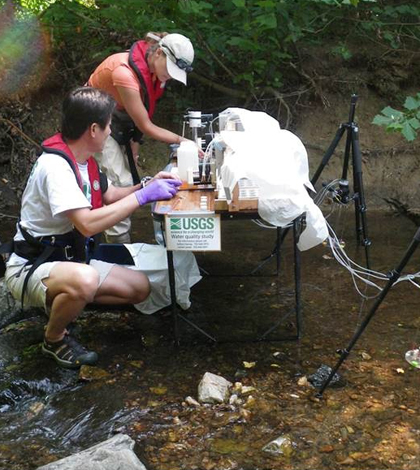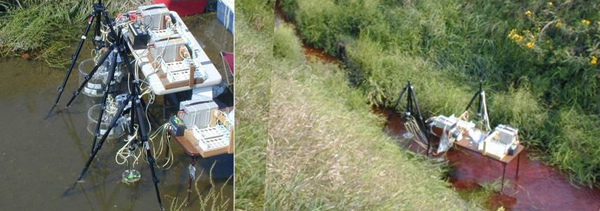USGS study: Shallow streambed chemistry filters nitrate from water

U.S. Geological Survey scientists sample water and sediment in Accotink Creek near Ranger Road in the City of Fairfax, Va. (Credit: Jud Harvey)
A recent study by the U.S. Geological Survey reveals that streams and rivers possess a natural filtration system capable of removing harmful nutrients such as excess nitrate from their waters. With a helping hand, this system could be optimized through restoration efforts, greatly improving the health of afflicted waterways.
The filtration process occurs by means of a hyporheic zone, a shallow layer of sediment through which water penetrates and flows. Taking its name from Greek words meaning “under the flow,” the hyporheic zone acts as a waterway’s skin and removes contaminants as water passes through the surface of the sediment.
“Although the amount of hyporheic flow is often small relative to the total flow in the stream, it may have a large effect on chemical reactions occurring in the water,” said hydrologist Jud Harvey of the USGS National Research Program in Reston, Va.
The hyporheic zone is an effective filter partly due to pressure fluctuations along the streambed, Harvey said. Higher streamflow velocity drives pressure fluctuations up, creating greater flow through the hyporheic zone. Sediment composition and particle size also influence hyporheic flow: gravel, for instance, permits ten times the flow of sand.
While sediment and pressure variation facilitate hyporheic flow, bacteria residing in the sediment are responsible for the final elimination of excess nitrate.
“Denitrifying bacteria are a consortia of bacterial species that metabolize nitrate,” Harvey said. They thrive in “zones within the sediment where nitrate and organic carbon are available, and where oxygen is absent.” The bacteria convert the dissolved nitrate into gaseous nitrogen, eliminating the nutrient from the water.
The USGS study found that the biochemical processes even occurred in streams with very thin skin — only four centimeters of sediment. The top four centimeters contain the largest population of bacteria and allow the most flow. Additionally, the surface layer of sediment provides the best conditions for oxygen-free micro zones to exist.
According to Harvey, two factors primarily determine the optimal thickness of the hyporheic zones.
“It’s won’t be the same everywhere, but will depend on how deep the flow goes in the bed during one ‘reaction time’,” Harvey said. The denitrification reaction time, he noted, is approximately one hour.
The other major factor is the efficiency of hyporheic flow in processing the stream, which is estimated by the magnitude of hyporheic flow divided by the stream’s discharge. The study employs a model that incorporates both factors, granting an estimation of removed nitrate per kilometer of water travel.

The Sugar Creek, Ind., study site and USGS sampling equipment. (Credit: Jud Harvey)
To better understand hyporheic flow, the study’s authors developed their own sampling equipment and tested 37 sites in two tributaries of Sugar Creek, Ind. The USGS MINIPOINT sampler was built specially for the job using a variety of stock equipment available from scientific supply catalogs. The MINIPOINT is not patented, and eager scientists can obtain design specifications from USGS.
“The resulting instrument pumps very small water samples simultaneously from six depths in the streambed,” Harvey said. The pumping is controlled in such a way that it does not affect the natural flow rate.
Despite the localized sampling, Harvey said the principles of hyporheic flow apply to nitrate-contaminated streams around the world.
Excess levels of nitrate damage waterways by causing eutrophication and creating hypoxic dead zones. Fertilizer runoff from agricultural operations is a leading cause of nitrate pollution.
Billions of dollars are spent toward stream restoration in the U.S., according to the USGS press release. However, many restoration efforts have resulted in waterways with deep hyporheic flow, providing fewer benefits than shallow hyporheic zones.
The study’s findings could be used by the U.S. Environmental Protection Agency to review federal jurisdiction in headwaters where processes such as hyporheic flow may benefit water quality downstream ecological health, Harvey said.
Top image: U.S. Geological Survey scientists sample water and sediment in Accotink Creek near Ranger Road in the City of Fairfax, Va. (Credit: Jud Harvey)





0 comments